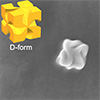| Sep 22, 2022 |
|
(Nanowerk News) Chirality is the property that the structure is not superposable on its mirrored image. Chiral materials exhibit the characteristic feature that they respond differently to left- and right-circularly polarized light (optical activity, Figure 1).
|
|
When a matter is irradiated with strong laser light, optical force exerts on it. It has been expected theoretically that the optical force exerting on chiral materials by left- and right-circularly polarized light would also be different.
|
 |
| Concept movie of the optical trapping of the chiral nanoparticles. The optical force exerting on the nanoparticle is dependent on the handedness of the circularly polarized incident light. (Animation: NINS/IMS)
|
|
The research group at Institute for Molecular Science and three other universities used an experimental technique of optical trapping to observe the circular-polarization dependent optical gradient force exerting on chiral gold nanoparticles (Figure 2).
|
|
Chiral gold nanoparticles have either D-from (right-handed) or L-form (left-handed) structure, and the experiment was performed using both. Although the optical gradient force acting on chiral nanoparticles was predicted theoretically, no observation of the force has been reported before.
|
 |
| Fig. 1 Responses of chiral materials differently to left- and right-circularly polarized light. Chiral materials exhibit the characteristic feature that they respond differently to left- and right-circularly polarized light (optical activity). The response of D-form molecule to left-circularly polarized light is same as that of L-form molecule to right-circularly polarized light, and vice versa. (Image: NINS/IMS)
|
|
The research group succeeded in observing the optical gradient force originating from the chirality (i.e., the difference between the gradient force by left- and right-circularly polarized light), by optical trapping of the chiral gold nanoparticles.
|
 |
| Fig. 2 Images of chiral gold nanoparticles. Scanning electron microscopy images show D- and L- form gold chiral nanoparticles. The insets visualize the three-dimensional models of the nanoparticles. (Image: NINS/IMS)
|
|
The results (Sciences Advances, “Optical Gradient Force on Chiral Particles”) showed that the optical gradient force was different for D-form and L-form particles (Figure 3).
|
|
They also found, from the dependence of the force on the wavelength of the light used, that there is a previously unknown effect on the mechanism of the chirality-dependent optical forces.
|
 |
| Fig. 3 Wavelength dependence of difference between the optical forces by left- and right-circularly polarized light. The plots are the experimental data and broken line are the theoretical calculation. Red and blue in the plots and line represents the D- and L-form nanoparticles, respectively. The optical gradient force was different for D-form and L-form particles. (Image: NINS/IMS)
|
|
The present study clarified the characteristics of the circular-polarization dependent optical gradient force on the mechanics of chiral gold nanoparticles. It shows the possibility of separation of chiral materials by the optical force, which may be realized and may extend the applications by using locally confined light generated on nanostructures to trap the materials and/or by utilizing the optical force by other mechanisms.
|





